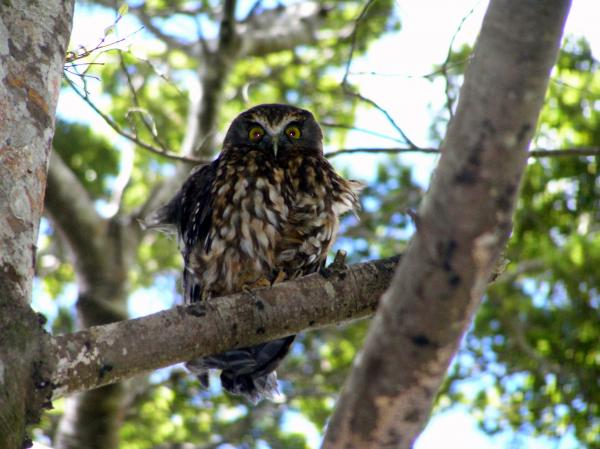
Walking home from the pub with a mate in deep conversation we came across an English family. They were disconsolate about a sick Morepork on the footpath. It was tiny, looked close to death and in a pool of what in the street light gloom looked like its own excreta.
We stopped, felt sheepish as they asked what could be done? In the sober light of day such a question could flummox one, let alone after a few pints. How do you actually revive a Morepork? We affected our best Kiwi pragmatism and pondered aloud. My friend inspirationally burped out the obvious answer, and in a moment of rare insight said, “Take it to Alan’s”. Alan is a neighbour whose wisdom on bush life would surely help.
The English family seemed comforted with this answer. We gently scooped up the failing bird and continued on our way.
There is something anthropomorphicly moving cradling a Morepork or Ruru. Its frame is tiny, warm and bony. Quizzical circular eyes started to squint open then flutteringly close. This is all notwithstanding Bullers “Birds of New Zealand” history of the Moreporks’ savage predatory behaviour on other birds.
Walking on, our conversation became more animated. My friend was rabbiting on about the Reverend Victor Penny, who the government paid and sent to Somes Island under armed guard, to develop secret military experiments on antimatter in the 1930’s. I thought this was a tall story and said so. The Morepork on my finger noticeably tensed when the discussion became animated.
It’s a bit of a walk along Marine Drive to my place in Mahina Bay. I suggested my friend might like to have a go carrying the bird. Gingerly we transferred the ailing bird to his hand. He said it started to grasp his finger like it was on a perch.
On we walked, the story about antimatter and its use in the military grew. The Morepork seemed to react more the debate heated up. I later found that the Sydney Morning Herald on 20 March 1936 had a front page story on the Rev Penny who under “close personal guard had been making experiments on Somes Island, Wellington to perfect an apparatus which projects an invisible ray that stops aeroplanes in flight.” Further in David McGills book “Island of Secrets” the Rev Penny’s experiments are promoted as ” a death ray developed with Government funding … the stuff of a comic novel”. Bizarrely the Government to day still refuses to open its files on Penny. What are they hiding? My companion was right – I forelock tuggingly now concede.
I look at Somes/Matu now in a somewhat different light from the quarantine station and war detention centre it once was. It was a habitat for science fiction hoaxes, and present government cover ups as well.
Finally we came to Mahina Bay. A walk up the hill would deliver the avian charge to my friend Alan. We again, gingerly transferred the bird. It weakly grasped my finger, squinting its watery eyes as it quizzed me in the street light, looked at my friend, sighed, and with a dismissive shake of its head made it plain it had enough of our nonsense conversation and falteringly flew off to alight clumsily on a bough on the cherry tree over the road. There it sat, smugly, peering down at us knowingly.
It is plain the owl is a wise bird, that can only put up with so much codswallop. Our robust answer to those concerned English people the way to revive a Morepork is unquestionably to ‘bore it to tears’.
On the other hand if faced with the dilemma we were presented with – and our boring talk remedy fails – ring 0800 DOC HOTLINE. They operate 24/7 and will likely put you in touch with our local Native Bird Rescue group. The DOC website has a section on caring for sick native birds – a warm electrolyte sports drink solution through a dripper might be the elixir.
Maybe that’s what we should have been drinking. But would then the Ruru have come to?
